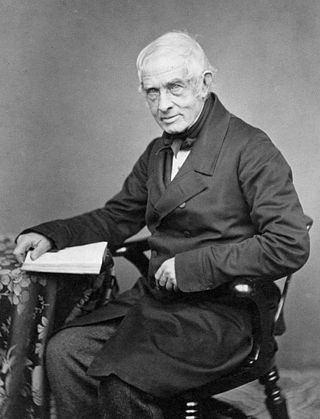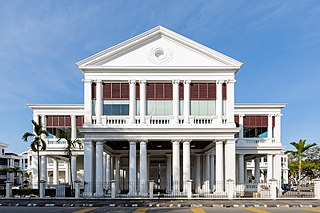
The Straits Settlements were a group of British territories located in Southeast Asia. Originally established in 1826 as part of the territories controlled by the British East India Company, the Straits Settlements came under control of the British Raj in 1858 and then under direct British control as a Crown colony in 1867. In 1946, following the end of World War II and the Japanese occupation, the colony was dissolved as part of Britain's reorganisation of its Southeast Asian dependencies in the area.

Sir Thomas Stamford Bingley Raffles was a British colonial official who served as the governor of the Dutch East Indies between 1811 and 1816 and lieutenant-governor of Bencoolen between 1818 and 1824. Raffles was involved in the capture of the Indonesian island of Java from the Dutch during the Napoleonic Wars. It was returned under the Anglo–Dutch Treaty of 1814. He also wrote The History of Java in 1817, describing the history of the island from ancient times. The Rafflesia flowers were named after him.

The legal system of Singapore is based on the English common law system. Major areas of law – particularly administrative law, contract law, equity and trust law, property law and tort law – are largely judge-made, though certain aspects have now been modified to some extent by statutes. However, other areas of law, such as criminal law, company law and family law, are largely statutory in nature.

The establishment of a British trading post in Singapore in 1819 by Sir Stamford Raffles led to its founding as a British colony in 1824. This event has generally been understood to mark the founding of colonial Singapore, a break from its status as a port in ancient times during the Srivijaya and Majapahit eras, and later, as part of the Sultanate of Malacca and the Johor Sultanate.

John Crawfurd was a Scottish physician, colonial administrator, diplomat, and author who served as the second and last Resident of Singapore.

The term "British Malaya" loosely describes a set of states on the Malay Peninsula and the island of Singapore that were brought under British hegemony or control between the late 18th and the mid-20th century. Unlike the term "British India", which excludes the Indian princely states, British Malaya is often used to refer to the Federated and the Unfederated Malay States, which were British protectorates with their own local rulers, as well as the Straits Settlements, which were under the sovereignty and direct rule of the British Crown, after a period of control by the East India Company.

Singapore in the Straits Settlements refers to a period in the history of Singapore between 1826 and 1942, during which Singapore was part of the Straits Settlements together with Penang and Malacca. Singapore was the capital and the seat of government of the Straits Settlement after it was moved from George Town in 1832.

William Petrie was a British officer of the East India Company in Chennai during the 1780s, and was Governor of Prince of Wales Island from 1812 to 1816. An amateur astronomer, Petrie helped found the first modern observatory outside Europe, the Madras Observatory.

St. George's Church is a 19th-century Anglican church within George Town in the Malaysian state of Penang. The oldest purpose-built Anglican church in Southeast Asia, it was elevated by to the status of pro-cathedral in 2023. The church lies within the jurisdiction of the Upper North Archedeaconry of the Anglican Diocese of West Malaysia.

Robert Fullerton was a Scottish colonial administrator who served as the first Governor of the Straits Settlements, appointed by the East India Company.

George Caunter was a British administrator who governed Prince of Wales Island as Acting Superintendent from 1797 to 1798 and again from 1798 to 1800. As First Assistant under Lieutenant-Governor Leith he negotiated the treaty that brought Province Wellesley under British sovereignty in 1800 and that provided, in British eyes, an unequivocal basis for British sovereignty over Penang Island. At various times Caunter further held the offices of marine storekeeper, master attendant, Chief Magistrate, Treasurer and Chaplain in Penang.
Philip Dundas was a Scottish East India Company naval officer, president of the East India Marine Board, and superintendent of Bombay. He returned to Britain and became a member of parliament and returned to the Far East to become governor of Prince of Wales Island, now known as Penang.
Sir Robert Townsend Farquhar, 1st Baronet was an influential British merchant of the early nineteenth century who served as a colonial governor and Member of Parliament. During his lengthy service for both the East India Company and the British government, Farquhar gained a reputation as an efficient and ambitious administrator and he notably served as Lieutenant-Governor of Prince of Wales Island from January 1804 to 1805 and as governor of Île de Bourbon, now known as Réunion from 1810 to 1811.
Colonel Norman Macalister was a Scottish officer in the Bengal Army and colonial administrator who was Lieutenant-Governor of Prince of Wales Isle (Penang) from 1808 to 1810.
Charles Andrew Bruce (1768–1810) was briefly Governor of Prince of Wales Island from March 24, 1810, until his death in office in December 1810. He is buried at the Old Protestant Cemetery, George Town, Penang, now in present-day Malaysia.
William Edward Phillips (1769–1858) was a British army officer and colonial administrator. He was acting governor of the Prince of Wales' Island on six occasions.

Robert Ibbetson was a colonial governor of the Straits Settlements of Penang, Malacca, and Singapore from 1832 to 1834.
The chief secretary of Singapore, known as the colonial secretary of Singapore before 1955, and the colonial secretary of the Straits Settlements before 1946, was a high ranking government official position in the Straits Settlements before 1946 and the Colony of Singapore after 1946, between 1867 and 1959. It was second only to the governor of Singapore, formerly the governor of the Straits Settlements in the colonial government.

The Penang High Court, founded in 1808, is the birthplace of Malaysia's judiciary system. It is housed inside a Palladian-style building at Light Street, George Town, Penang. To this day, the High Court sits at the top of Penang's hierarchy of courts.













